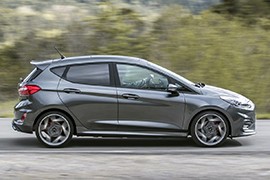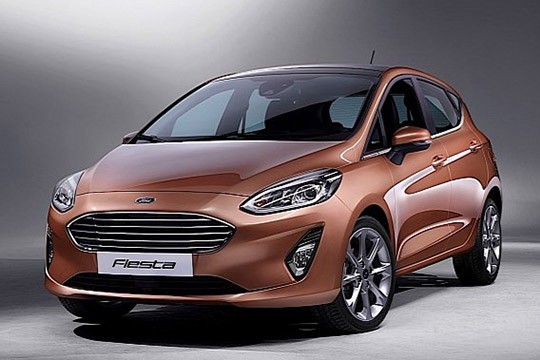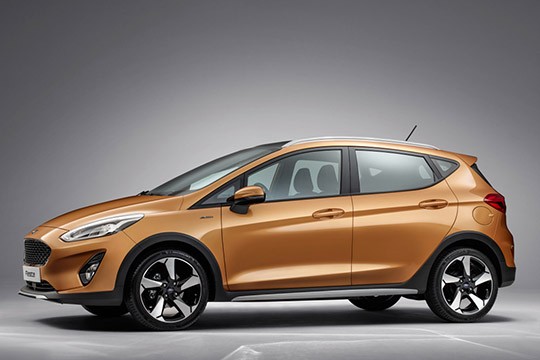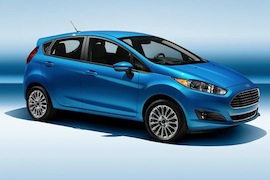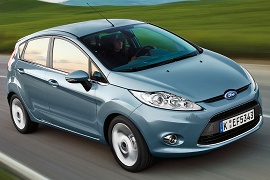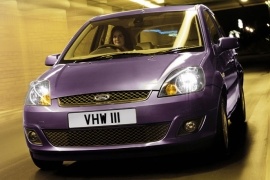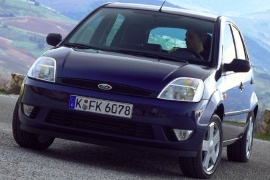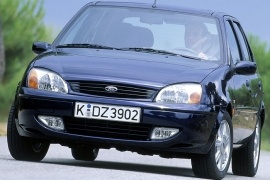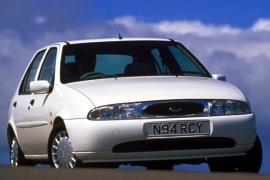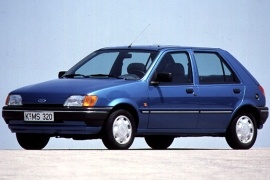FORD Fiesta 5 Doors Models/Series Timeline, Specifications & Photos
First production year: 1989
Engines: Mild hybrid, Gasoline, Diesel, Natural gas
Body style: Hatchback
Ford refreshed the Fiesta Active model in 2021 and enhanced its drivetrain with electrified versions while it dropped the turbodiesel engines on the way.
In 2017, Ford introduced the seventh generation of the Fiesta lineup and added a crossover version named Active. The carmaker tried to compete against the market leader Renault Captur, which was also based on a small-segment vehicle, the Clio. Five years later, the blue-oval brand added a well-deserved facelift for the entire Fiesta range, including the Active version.
Regardless of the technological improvements, a carmaker has to upgrade the exterior of a refreshed car, and Ford knew that. The most striking innovation was on the front bumper, which received a new, L-shaped set of trims on the side scoops. Since the carmaker added the Matrix-LED headlights, the overall front look of the vehicle showed a bolder stance on the road. In addition, its grille featured vertical slats instead of the mesh design used for the 2017 model year. At the back, the carmaker offered the Active with an option for LED taillights.
Changes continued on the interior where Ford installed a 12.3” digital instrument display, which replaced the former analog dials. Atop on the center stack, Fiesta Active featured the same infotainment system as its non-facelifted version.
But the most significant change was under the hood, where Ford dropped the fuel-efficient turbodiesel engines. Instead, it replaced them with new, mild-hybrid versions with a 48-volt architecture that complemented the regular, inline-three gasoline powerplants.
The small hot-hatch industry is a trend that gathers more and more fans around the world. Ford has launched a new version of the Fiesta ST in 2018, with more power and fewer cylinders. But it is not a slow car in its class.
The Fiesta ST looks a little bit angrier than the other siblings. There are a different bumper and a different grille. It can also be equipped with full LED headlights. On the side, the 18” light-alloy wheels are offered as standard. The nice thing about the Fiesta ST is that it is only in three doors. As a final touch of sportiness, in the rear on top, there is a roof spoiler and a rear splitter, plus two exhaust pipes for those 3 cylinders under the hood.
Inside, there is a nice welcome air of sportiness with the two Recaro bucket seats. The rear seats are just normal, nothing fancy. There is not much room in there, but they do exists and can be used for short distances. The infotainment system is good and offers a navigation system, Apple CarPlay and Android Auto.
On the performance side, the 1.5-liter turbo engine offers 200 hp mated to a 6-speed manual. A piece of great news is that there is also an LSD differential for the front wheels that plays its part in the 0-100 kph (0-62 mph) sprint, which is completed in 6.5 seconds.
In 2017, Ford showed its new generation Fiesta as a full lineup, in four versions: 3 and 5 doors, Fiesta Active as a crossover and the performance-inspired ST-line. For those who want more luxury from a small vehicle, Ford introduced the Vignale trim. Fiesta is also the first Ford vehicle to feature a premium Bang&Olufsen Sound System, and for the first time offers an openable panoramic glass roof.
For the engine compartment, Ford installed a 1.0-liter EcoBoost, 3-cylinder unit, which is offered with 100 hp, 125 hp and 140 hp, and a new 6-speed manual gearbox. For the 100 hp version, Ford also offers a 6-speed automatic transmission with paddle shifters. For the diesel fans, there is only a 1.5-liter TDCi with 120 hp.
Inside, there are many features meant for comfort, safety and even a touch a luxury. The infotainment system consists of an 8” tablet connected to the N-SYNC system, which acts as a personal assistant. With an Internet connection, the system can look for restaurants, parking lots, stores and gives feedback regarding the traffic ahead.
For the safety systems, Ford ensured a multitude of features, including traffic recognition. The Fiesta is the first Ford in Europe to benefit from computer simulation crash tests of a complete vehicle using advanced new Finite Element Analysis technology, enabling more effective optimization of safety features from airbags to body structure reinforcements.
FORD Fiesta 5 doors 1.0L EcoBoost 6AT (100 HP)
FORD Fiesta 5 doors 1.0L EcoBoost 6MT (100 HP)
FORD Fiesta 5 doors 1.0L EcoBoost 6MT (125 HP)
FORD Fiesta 5 doors 1.0L EcoBoost 6MT (140 HP)
FORD Fiesta 5 doors 1.1L 5MT (70 HP)
FORD Fiesta 5 doors 1.1L 5MT (85 HP)
Ford introduced the Active trim level for the seventh generation Fiesta in 2017 and promised a better ride over bumpy roads and higher ground clearance for safe drives over unpaved roads.
While it wasn’t a true SUV, the Fiesta Active was more of a lifestyle vehicle able to cope better with tight parking spots, and its higher ground clearance made it better against curbs.
Ford didn’t want to invest too much for a small-sized crossover. It already had the Eco Sport model, to tried to expand its offer with a Fiesta-inspired model. Thus, it jacked up the small-sized vehicle suspension, replaced the bumpers, and called it a day. Nevertheless, the car’s LED daytime running lights that ran inside the headlights and the foglights that guarded the lower grille made a good impression in front of the customers. Moreover, the mesh-grille design looked handsome for a car in that class.
Inside, the main difference between the Fiesta Active and the rest of the range was the specific upholstery with a center line embroidered on the seats’ fronts. The car featured the same instrument cluster as the rest of the Fiesta range, with two analog dials and a TFT between them.
Under the hood, Ford installed a range of gasoline or turbodiesel engines paired with either a manual or an automatic transmission. The carmaker offered the Fiesta Active exclusively as a front-wheel-drive vehicle and with a five-door configuration.
Since Ford Fiesta’s introduction on the market in 1976, the small vehicle grew in size and was constantly improved in every aspect, enjoying great success along the years. Since its launch until 2013, the Fiesta was sold in more than 15 million units around the world.
A major facelift of the sixth generation was unveiled to the public in late September 2012 and went on sale in 2013.
Just like a breath of fresh air, both 3-door and 5-door body styles were redesigned for more style and appeal.
Besides the revised exterior design, the then-new Fiesta featured a new in-car entertainment, as well as new powertrains available.
Regardless of the body style, the Fiesta was available with both economic and sporty engine configurations,
It's been offered as a three and five-door hatchback versions and it was available with both economic or sporty engine configurations.
The 2013 model had a different front bumper and a completely refreshed grille that was bigger, wider and had a new design. With the ST Line trim level, the exterior design became more aggressive with a sporty suspension and lower ground clearance, as well as a new lip spoiler, a rear diffuser and a roof spoiler.
Worth mentioning, besides the new SYNC infotainment system, the Fiesta was equipped with a system that allowed parents to limit the speed and volume, as well as muting the stereo until the seatbelts were fastened. The system was named MyKey.
Fitted with the 1.0-liter EcoBoost gasoline engine, the Fiesta develiered the best-in-class fuel economy.
FORD Fiesta 5 Doors 1.0L 5MT FWD (65 HP)
FORD Fiesta 5 Doors 1.0L 5MT FWD (80 HP)
FORD Fiesta 5 Doors 1.0L EcoBoost 5MT FWD (100 HP)
FORD Fiesta 5 Doors 1.0L EcoBoost 5MT FWD (125 HP)
FORD Fiesta 5 Doors 1.25L 5MT FWD (60 HP)
FORD Fiesta 5 Doors 1.25L 5MT FWD (82 HP)
FORD Fiesta 5 Doors 1.6L Ti-VCT 5MT FWD (120 HP)
The sixth-generation Ford Fiesta revealed in 2007 at the Frankfurt Motor Show featured Ford’s kinetic design philosophy introduced in 2006.
Compared to the previous generation Fiesta, the exterior design was a huge change, expressing agility and attitude. The agile look was given by the big grille on the lower part of the bumper that incorporated the license plate bracket. The sweeping roofline ended into a small spoiler, while the very angled A-pillar added to the dynamic look.
Both the 3-door and the 5-door versions were based on the same body, thus the 5-door didn’t feature a less sporty or dynamic design.
Built on Ford’s new global B-car platform, the new Fiesta featured a simple suspension layout with McPherson struts on the front and semi-independent rear suspension.
Compared to the 3-door version, the Fiesta 5-doors came with a bigger glass area that created a roomier feel inside the cabin.
Inside, the Fiesta 5-doors featured a roomy cabin for the front occupants, while rear passengers were not the happiest with the limited headroom and legroom.
The interior was pretty modern for 2008 and depending on the trim level, it featured automatic climate control, heated power side mirror and an automatic gearbox.
Both gasoline and turbo-diesel engines were available and could be paired with a 5-speed or a 6-speed standard manual transmission depending on the powerplant fitted.
Ford introduced the fifth generation of the Fiesta in 2002, and, surprisingly, it came with a refreshed version just three years later.
With the 2005 refresh, Ford tried to make its cars safer, and it succeeded. It needed better grades from the EuroNCAP crash tests, which meant more safety systems in the base trim level. Also, worth mentioning that starting with January 2005, all vehicles had to comply with the new, Euro4 regulations.
From the outside, Ford's designers didn't seem to work too hard. At the front, it featured better headlights with clear lenses and a slightly reshaped grille. There was an improvement in the bumper design as well, which received a set of fog-lights, depending on the trim level.
Inside, Ford improved the car's dashboard and changed some materials to make the car more pleasant for the passengers. The base trim level featured black plastic everywhere on the dashboard and door panels, with no tachometer inside the instrument cluster. Ford offered automatic climate control, power windows front and back, and power mirrors for the upper trim levels. The audio system was upgraded and received a CD-player.
Ford already updated the technical part of the car to the Euro 4 requirements. For specific versions, the carmaker installed standard ESP to make the car safer on the road. Under the hood, the carmaker installed a choice of five gasoline and two diesel engines paired either to a 5-speed manual or a 4-speed automatic gearbox.
Ford continued the successful Fiesta range in 2004 with the introduction of the sixth generation. Its small dimensions made it an excellent contender in the small-class segment.
With the new wave of vehicles introduced by Peugeot-Citroen, Renault, Fiat, and Opel on the market, Ford had to make a bold move and get a front seat on the small-segment sales charts. The Fiesta was a good answer, and helped by its brand awareness, it succeeded. Ford offered a good vehicle with enough interior room, good features, and a decent engine choice.
The designers had to build a roomy interior inside a small-sized vehicle. The most logical answer was a boxy-looking car. But they were able to imagine a front fascia with sloped headlights and a small grille between them. The five-door version offered good access for the front seats and decent for the rear ones, especially for kids. On top of the tailgate, a small roof-spoiler was available for selected versions. Its taillights were mounted high on the C-pillars to protect them against small bumps in the parking lot.
Due to the boxy exterior, the interior was roomy for four adult passengers. There was little room in the back for three occupants, but it was enough for short, in-city trips. The Fiesta didn't offer power mirrors for the base levels, but the AC was fitted as standard for most of the range. The floor-mounted gearstick was part of the center console. On the center stack, a radio-cassette player was standard as well. A CD-player was on the options list.
Under the hood, the Fiesta 5-doors was fitted with a 1.2-liter gasoline engine, while the top version featured a 101 hp unit. The diesel versions were developed with Peugeot-Citroen, resulting in two versions that produced 68 hp or 90 hp.
Ford introduced the fourth generation of the Fiesta in 1995 and refreshed-it in 1999. Although it wasn't a completely new car, it had a totally different face.
Ford tried and gained with the New-Edge design language used for the first generation of the Focus and for the sporty little Puma. The idea was to combine long and curved lines in sharp angles. The compact-sized vehicle was such a success that the blue-oval management decided to apply the same theme on the smaller Fiesta.
From the oval-shaped headlights to the triangular ones, it was a complicated design process that imposed new fenders, hoods, and grille. The rear panel, quarter panels, and the tailgate were redesigned to accommodate a new set of taillights designed in the same trend in the back.
The interior was still part of the biodesign era, with rounded shapes and a curved dashboard. But Ford changed here and there a few buttons and the audio system. For the Ghia trim level, the designers installed a wood-trim, which might have looked better on a larger car than in a small-segment vehicle. The interior room was good for a family of four with adequate legroom in the back. Its trunk was big enough for weekly shoppings and, if there was more room needed, the seatback of the rear seat was folding in one piece.
For the 1999 Fiesta, Ford dropped the 1.1-liter engine and made the 1.3-liter unit the base version. A new, 1.25-liter ZETEC engine was installed and offered 75 hp. For selected markets, the Fiesta featured a 1.6-liter engine. An improved 1.8-liter turbodiesel version was introduced.
The 1995 Fiesta was one of the best cars in its class when it was introduced, and its main advantages were the low running costs.
The fourth-generation Fiesta and the sixth generation of the Escort used the same recipe to use an older platform with a new exterior design. While the Escort was more of a facelift, the Fiesta's design went through a more significant upgrade.
The designers might not have been very inspired when they drew the front fascia of the 1995 Fiesta, and, at a glance, some might say that the car looked sad. Its new headlights and the oval-shaped grille were just a part of the "sad-look." Even the lower bumper grille looked like a sad mouth. Depending on the trim level, the door-mirrors were black or body-colored. Standard versions were fitted with steel wheels, while the top versions were offered with a set of light-alloy ones.
The interior was part of the biodesign era, with rounded shapes and a curved dashboard. Depending on the trim level and options, the Fiesta featured a radio-CD player on the center stack. The interior room was good for a family of four with adequate legroom in the back. The trunk was big enough for weekly shoppings and, if there was more room needed, the seatback of the rear seat was folding in one piece.
One of the most important advantages of the Fiesta was the Ford B4 platform, which was very good while cornering. The engine ranged between 1.25-liter gasoline and a 1.8-liter diesel.
The third generation of the Fiesta was the first to receive a 5-door version, which led to a huge commercial success on the European market.
While the Eastern Europe communist countries were free again, a new market was opened for the car manufacturers. It was perfect timing for Ford to introduce a small, five-door vehicle, which was more affordable than most of the other German vehicles on the market. Its calculations were right.
For the design, Ford already decided to have similarly shaped headlights on its cars, and the Fiesta followed the rule. The corner-mounted turn signals mimicked the ones found on its bigger brothers, the Escort, the Sierra, and the large Scorpio. With its black handles on the doors, the car offered better access inside than most of the vehicles built in the East-European countries.
Inside, a new design trend broke the angular lines of the past and brought the new, smoother lines of the '90s. It was the dawn of the biodesign era. The center-mounted speedometer and the race-inspired look for the tachometer were a good sign of evolution for the small-segment Ford car. The Fiesta was offered with a sunroof, radio-cassette player, air-conditioning, and power-windows on the options list.
Ford promised to offer fuel-efficient engines and installed a choice of three gasoline units and a diesel. All of them were paired to a 5-speed manual transmission.

